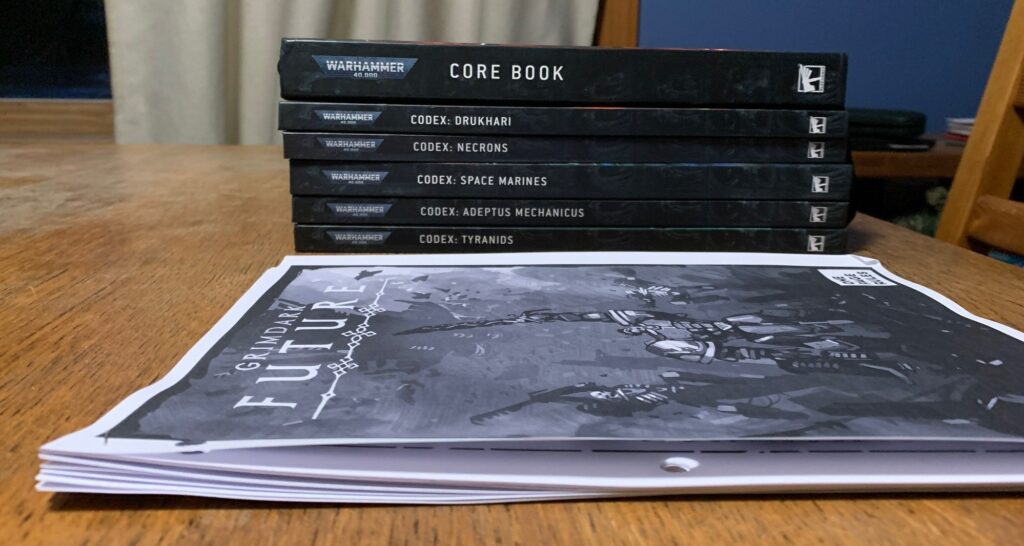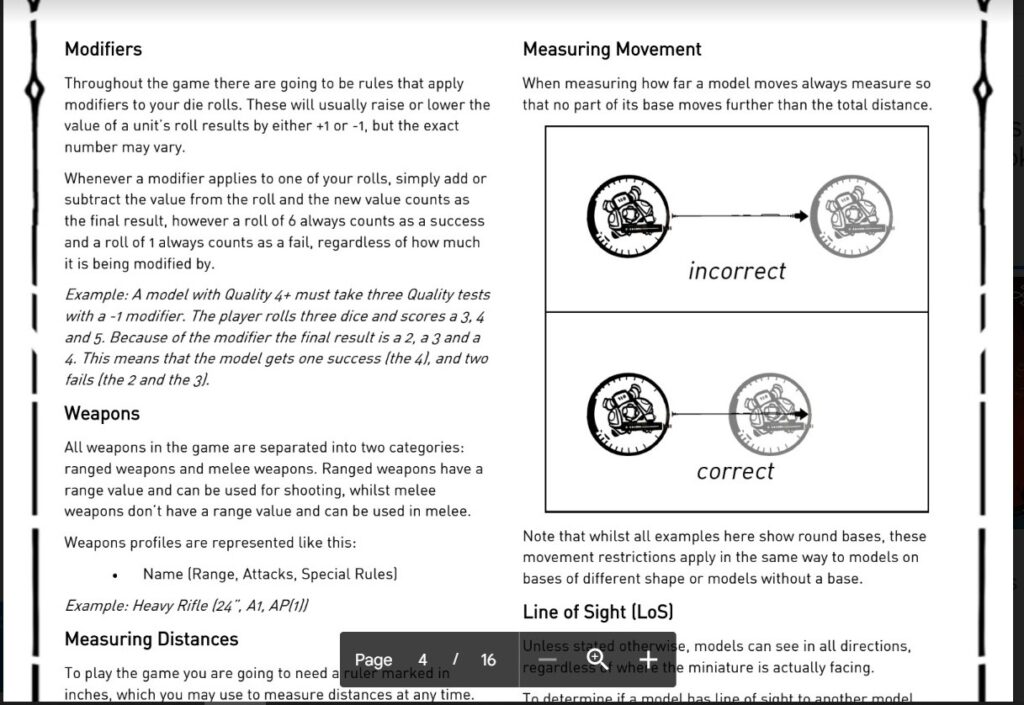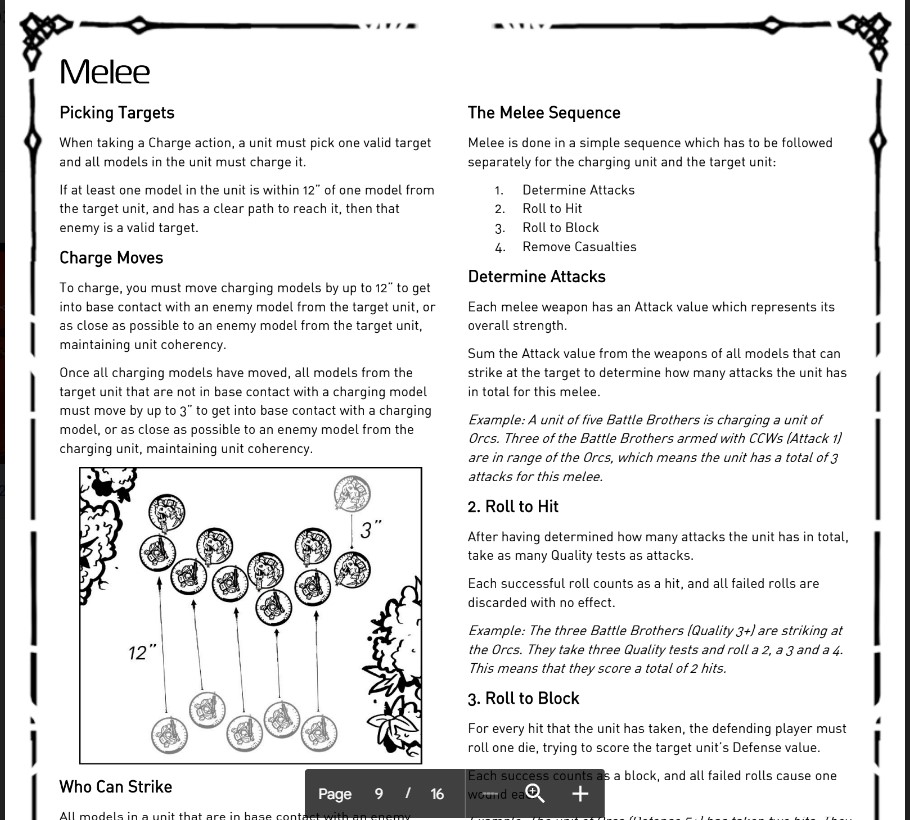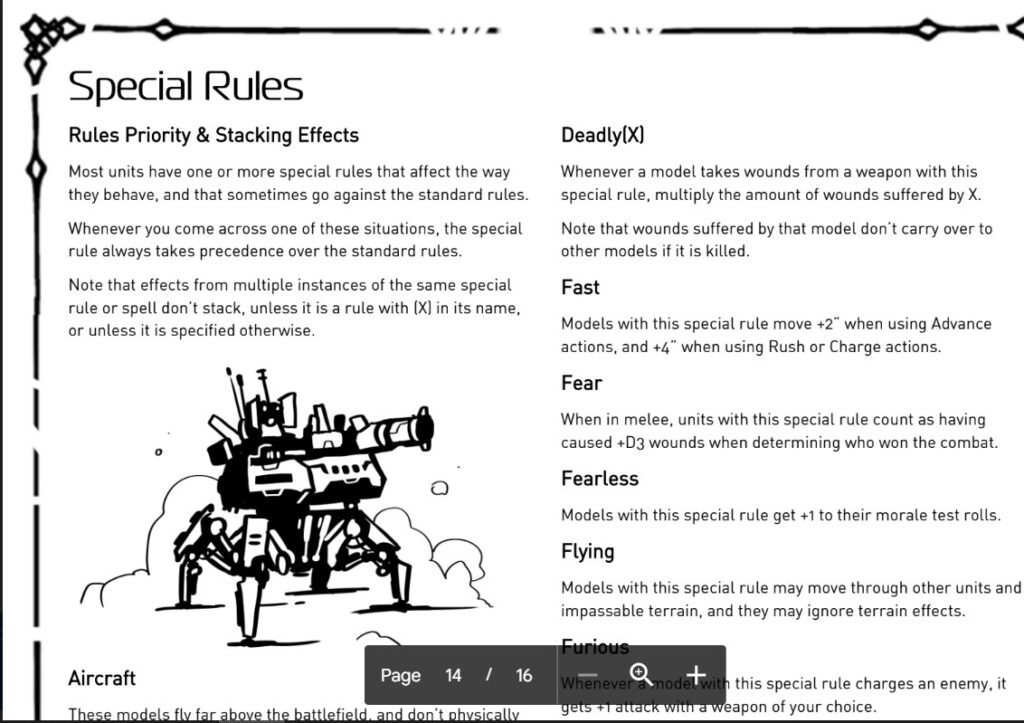IN MY PREVIOUS POST, I discussed how fatigued I am with the bloated mess that is 9th Edition 40K. There are a lot of rules, some of them very complicated, and they change quite often. For a casual gamer like me, it can be too much to keep track of, not to mention very expensive, what with buying new rulebooks every few years. So that’s why I’m walking away from 40K after 35 years of playing, and I’ll probably never come back.
But that doesn’t mean I’m going to be selling my models or pitching them into a landfill. Not when I’ve found an alternative with much simpler, easier-to-use rules—and they’re absolutely free to download. Not when there’s Grimdark Future from gaming upstart OnePageRules.

Grimdark Future is OPR’s stripped-down, bare-bones version of Warhammer 40K. It deliberately doesn’t have anywhere near the options, the intricacies, and nuances of 9e 40K. Basic rules are simple, army options are few, and there are no Stratagems.
If you’re a competitive gamer, GDF may not be to your liking. But if you just want to have a good time moving some minis and rolling dice while you hang out with your friends and quaff some beers, GDF is for you. Let’s take a look.

The Rules
The essential rules you need to play really do fit on a single page; the basic rulebook itself with everything else pertinent comes in at 16 pages. There’s a full rulebook available to Patreon subscribers, with additional, advanced content, but all of it is still much, much less to learn than what you find in the 40K core rulebook.
Army rules are even lighter: the writeups for each faction (of which GDF has several, including some 40K doesn’t) are usually only two or three pages, encompassing stats for units and wargear, unique rules, and psychic powers (if applicable). To avoid intellectual property infringement, GDF uses generic names: their Adeptus Astartes are “Battle Brothers;” Drukhari are “Dark Elf Raiders;” and Tyranids are “Alien Hives.”

And have I mentioned that all of this—the basic rules, as well as those for each and every army—is free of charge? It doesn’t cost a single dollar, euro, krona, lira, ruble, rupee, yuan, or yen. You don’t even need to provide your email address: no catch, no strings attached. Just go to their website, download what you need, and get started.

How It Works
Grimdark Future is very similar to 40K. If you’ve had at least one 40K game under your belt, you should have no trouble playing GDF.
Two players pick a point value for their army, select their models, and deploy their forces on a board set up with terrain. Armies consist of units whose members must stay within coherency of each other. Players take turns moving units one at a time; units then shoot or fight in close combat. Dice rolls determine success in hitting and killing enemy models, as well as maintaining morale. Games consist of four turns, with the winner determined by which player has captured the most objectives.

There are, however, some key differences.
“I-Go-You-Go” More Often. Since its inception, 40K has used an “I-Go-You-Go” system where one player moves all their units, then shoots with them, then charges and fights with them (as the case may be).
All this time, the other player stands around, waiting to roll dice and remove figures in response to the first player’s actions. If a player’s army has a lot of figures (as is usually the case for Orks or Tyranids), their Movement phases can take a while, with the other person doing nothing. In GDF, players act much more frequently, which I’ll get into next.
There Are No Phases. In GDF, there are no phases for moving, shooting, fighting, or whatever. Instead, the first player “activates” a single unit, moving and shooting/fighting with it. When they’re done with that unit, the second player “activates” a unit of their own. Then the first player activates another unit, the second player activates another of theirs, and so on, until all units in both armies have done something. It makes for a much more interesting, dynamic game, where feints and countermoves can play a bigger part than they do in 40K.
Shoot or Charge, Not Both. Units in GDF can choose to move up to 6″ (or not) and shoot (or not). They can “Rush” and move an additional 6″, but do nothing else. Or instead of moving and shooting, they can “Charge” up to 12″ to get into base-to-base contact with at least one enemy model, and then fight in close combat. But they cannot move, shoot, and then charge.

No Staying “Stuck In…” In previous 40K editions, units could easily become bogged down in Fight Phase slugfests they might not want to be in. Eighth and Ninth Edition mitigated this by allowing units to Fall Back from these close combats, albeit without being able to do anything but beat feet.
In GDF, after a unit finishes fighting in melee, it immediately moves 1” away from the enemy it was engaging. This allows the enemy unit to move away, or shoot or Charge the attacking unit (or another unit). So, if a squad of “Orc Marauders” jumps some of your “TAO Coalition” Fire Warriors Grunts, fret not.
…But “Fatigue” is a Thing. If a unit fights more than one melee combat in a round (say, if it was attacked by two enemy units), then after the first time, it needs unmodified 6’s to hit. Units under attack can decide whether they will fight back or not, which is useful if they’re facing more than one enemy.
How so? For example, if one of your Battle Brother squads gets charged by a herd of Goblins, you might want to just let the weedy little Muppets flail uselessly on you so that when the Orc mob following them comes to throw hands, your guys can properly punch them in their snaggletooth mouths.

Streamlined Stats. GDF units don’t have characteristics like Move*, Ballistic Skill, Weapon Skill, Strength, Toughness, etc. Instead, they just have numerical values for “Quality”—used to determine how well a unit hits or holds up its morale—and “Defense”—how well it shrugs off enemy attacks. That’s it.
*Unless specified otherwise (such as when Rushing or Charging), all models move 6″.
In combat, dice rolls are made and compared to the appropriate number to determine what happens. A roll equal to or greater than the Quality or Defense value (as appropriate) succeeds; a roll below fails. As you might expect, a standard unit of “Battle Brothers” has Quality and Defense of 3+, respectively, so they hit targets on 3 or higher, and survive (or “Block”) enemy attacks on a 3 or higher. Modifiers for terrain and weapons can affect these rolls.
No Rolls “To Wound.” If a model scores a hit on an opposing model, whether by shooting or in close combat, it’s assumed to be “a hit, a very palpable hit,” as the Bard said in Hamlet. There’s none of the frustration of nailing an enemy tank with a lascannon shot, only to come up with a “1” on the “to wound” roll and have it fail to do anything besides leave a scorch mark.
Pinned or Routed? Depending on circumstances, units that fail morale checks (in a process similar to that in 40K) are either Pinned or Routed. Pinning usually happens after being shot at, though it can also result from close combat. Routing only happens after melee.
Pinned units can’t move or shoot as they take their next Activation getting their poop back together. If they’re charged, they need unmodified 6’s to hit, and they’ll automatically fail any other morale tests they’re forced to make.
If a unit fails a morale test after losing a melee, and it has less than half its starting strength, it gets out of Dodge pronto, fleeing the battle. The player pulls those models off the board.
That’s It. No, Really, That’s All There Is
I take it back: there are some basic rules for terrain, as well as some special rules (“Aircraft,” “Blast,” “Fast,” “Relentless”) very much like you’ve seen in various iterations of 40K. But other than that, yeah, that’s pretty much the entire game. As I said, 16 pages of very easy to read and understand rules (with some nice, old-school black-and-white artwork).

If you’d like to try GDF, you can find it here. Next time, I’ll talk about the armies of the Grimdark Future.
Kenton Kilgore writes killer SF/F for young adults and adults who are still young. The Fighting Tigers of Veda appear in his latest novel, Stray Cats, which you can find here.

Check him out on kentonkilgore.com, and follow Kenton on Facebook for frequent posts on sci-fi, fantasy, and other speculative fiction. You can also catch him on Instagram, and find his books in softcover and for Kindle on Amazon.
